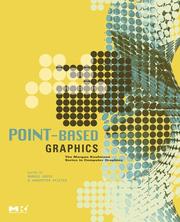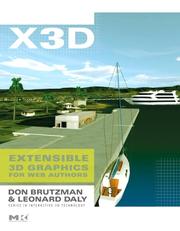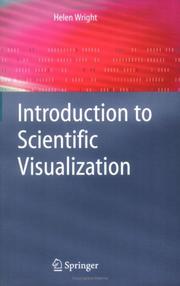| Listing 1 - 10 of 11 | << page >> |
Sort by
|
Book
ISBN: 1424408091 1424408083 1509087117 Year: 2007 Publisher: IEEE
Abstract | Keywords | Export | Availability | Bookmark
 Loading...
Loading...Choose an application
- Reference Manager
- EndNote
- RefWorks (Direct export to RefWorks)
Information visualization --- Computer graphics --- Information display systems
Book
Year: 2007 Publisher: Washington, DC : Federal Aviation Administration, Office of Aerospace Medicine,
Abstract | Keywords | Export | Availability | Bookmark
 Loading...
Loading...Choose an application
- Reference Manager
- EndNote
- RefWorks (Direct export to RefWorks)
Information display systems --- Air traffic control --- Electronic equipment
Book
ISBN: 9780819467300 0819467308 Year: 2007 Publisher: Winter Park, FL : Bellingham, Wash. : JCD Publishing ; SPIE,
Abstract | Keywords | Export | Availability | Bookmark
 Loading...
Loading...Choose an application
- Reference Manager
- EndNote
- RefWorks (Direct export to RefWorks)
Book
Year: 2007 Publisher: Washington, DC : Federal Aviation Administration, Office of Aerospace Medicine,
Abstract | Keywords | Export | Availability | Bookmark
 Loading...
Loading...Choose an application
- Reference Manager
- EndNote
- RefWorks (Direct export to RefWorks)
Information display systems --- Air traffic control --- Electronic equipment
Book
ISBN: 0769528872 1509089357 Year: 2007 Publisher: [Place of publication not identified] IEEE Computer Society
Abstract | Keywords | Export | Availability | Bookmark
 Loading...
Loading...Choose an application
- Reference Manager
- EndNote
- RefWorks (Direct export to RefWorks)
Computer vision --- Information visualization --- Information display systems --- Computer graphics --- Image processing --- Engineering & Applied Sciences --- Applied Physics

ISBN: 1281119008 9786611119003 0080548822 0123706041 Year: 2007 Publisher: Amsterdam ; Boston : Morgan Kaufmann,
Abstract | Keywords | Export | Availability | Bookmark
 Loading...
Loading...Choose an application
- Reference Manager
- EndNote
- RefWorks (Direct export to RefWorks)
The polygon-mesh approach to 3D modeling was a huge advance, but today its limitations are clear. Longer render times for increasingly complex images effectively cap image complexity, or else stretch budgets and schedules to the breaking point. Point-based graphics promises to change all that, and this book explains how. Comprised of contributions from leaders in the development and application of this technology, Point-Based Graphics examines it from all angles, beginning with the way in which the latest photographic and scanning devices have enabled modeling based on true geometry
Computer graphics. --- Three-dimensional display systems. --- 3-D display systems --- 3D display systems --- Display systems, Three-dimensional --- Automatic drafting --- Graphic data processing --- Graphics, Computer --- Information display systems --- Three-dimensional imaging --- Computer art --- Graphic arts --- Electronic data processing --- Engineering graphics --- Image processing --- Digital techniques

ISBN: 9780120885008 9780080489889 012088500X 0080489885 9786611053215 6611053212 128105321X Year: 2007 Publisher: Amsterdam Boston Elsevier/Morgan Kaufmann
Abstract | Keywords | Export | Availability | Bookmark
 Loading...
Loading...Choose an application
- Reference Manager
- EndNote
- RefWorks (Direct export to RefWorks)
In the early days of the Web a need was recognized for a language to display 3D objects through a browser. An HTML-like language, VRML, was proposed in 1994 and became the standard for describing interactive 3D objects and worlds on the Web. 3D Web courses were started, several best-selling books were published, and VRML continues to be used today. However VRML, because it was based on HTML, is a stodgy language that is not easy to incorporate with other applications and has been difficult to add features to. Meanwhile, applications for interactive 3D graphics have been exploding in areas such
Computer architecture. Operating systems --- 3D computertoepassingen --- 3D (derde dimensie) --- websites --- Open Source --- webdesign --- Computer animation --- X3D (Standard) --- Web sites --- Three-dimensional display systems. --- XML (Document markup language) --- Extendible Markup Language (Document markup language) --- eXtensible Markup Language (Document markup language) --- Document markup languages --- 3-D display systems --- 3D display systems --- Display systems, Three-dimensional --- Information display systems --- Three-dimensional imaging --- Web site development --- Microformats --- Extensible 3D graphics (Standard) --- Three-dimensional display systems --- Standards. --- Design. --- Authorship --- Standards

ISBN: 1281340103 9786611340100 1846287626 1846285917 1447158830 Year: 2007 Publisher: London : Springer London : Imprint: Springer,
Abstract | Keywords | Export | Availability | Bookmark
 Loading...
Loading...Choose an application
- Reference Manager
- EndNote
- RefWorks (Direct export to RefWorks)
Computer generated 3D animation has matured over the years into a rich and complex art form. The need to animate diverse characters has caused character animation to become an extensively researched area. Coordinating and presenting the character's movement in three dimensions to convey a specific idea to the audience, however, still remains a challenge. The animator has to employ a lot of artistic and technical skills, and often a labourious iterative trial-and-error process to get it right. It is even more difficult for the animator to generate the character's action if the point of view (i.e., the rendering camera) is also varying. Creating moving camera character animations in 3D is, however, a multi-faceted computer graphics and computer vision problem. It warrants a formal representation of the moving camera, and efficient algorithms to help author the multitude of character poses required for the animation. It is also necessary to deal with issues pertaining to camera and character pose interpolation and visualization of the association between the two. The solution to this problem has to be efficient and elegant from the perspective of a computer scientist, yet at the same time make sense and be intuitive to use. This well-researched book develops and demonstrates a framework for view-dependent animation designed to solve these issues, well illustrated with a large number of example animations to explain and illustrate this versatile technique.
Computer animation. --- Three-dimensional display systems. --- 3-D display systems --- 3D display systems --- Display systems, Three-dimensional --- Information display systems --- Three-dimensional imaging --- Animation, Computer --- Computer-assisted filmmaking --- Computer-generated animation --- Animation (Cinematography) --- Computer graphics --- Computer vision. --- Computer graphics. --- Computer Imaging, Vision, Pattern Recognition and Graphics. --- Computer Graphics. --- Automatic drafting --- Graphic data processing --- Graphics, Computer --- Computer art --- Graphic arts --- Electronic data processing --- Engineering graphics --- Image processing --- Machine vision --- Vision, Computer --- Artificial intelligence --- Pattern recognition systems --- Digital techniques --- Optical data processing. --- Optical computing --- Visual data processing --- Bionics --- Integrated optics --- Photonics --- Computers --- Optical equipment

ISBN: 1846287553 1846284945 Year: 2007 Publisher: London : Springer London : Imprint: Springer,
Abstract | Keywords | Export | Availability | Bookmark
 Loading...
Loading...Choose an application
- Reference Manager
- EndNote
- RefWorks (Direct export to RefWorks)
Scientific visualization is recognised as important for understanding data, whether measured, sensed remotely or calculated. Introduction to Scientific Visualization is aimed at readers who are new to the subject, either students taking an advanced option at undergraduate level or postgraduates wishing to visualize some specific data. An introductory chapter on the philosophy of the subject sets the scene, showing why visualization works and what to aim for when presenting scientific data visually. Then, extending and applying Brodlie's taxonomy to underpin its core chapters, the book shows how to classify data, choose a technique that's appropriate for its visualization, and alerts readers to some of the pitfalls before they can invalidate their conclusions. The book concludes with an annotated bibliography and suggestions for further reading. Above all, this is a 'how to do it' book for scientific visualization, with: Discussion of the different types of software architecture for visualization Introduction to the theory of colour perception and the role of colour in conveying information about data Comprehensive illustrations throughout Exercises and problems to encourage further learning Virtual laboratories available from Springer’s website for those readers with access to the IRIS Explorer package Dr. Helen Wright is a Senior Lecturer in the Computer Science department at the University of Hull. She has many years experience teaching scientific visualization to undergraduates and postgraduates, and the material used in this book has been tested through successive taught courses.
Information visualization. --- Information display systems. --- Data display systems --- Display systems, Information --- Dynamic display systems --- Electronic displays --- Computer input-output equipment --- Computers --- Optical data processing --- Optoelectronic devices --- Teaching --- Data visualization --- Visualization of information --- Information science --- Visual analytics --- Optical equipment --- Aids and devices --- Information theory. --- Computer graphics. --- Computer simulation. --- Computer aided design. --- Computer science. --- Theory of Computation. --- Computer Graphics. --- Simulation and Modeling. --- Computer-Aided Engineering (CAD, CAE) and Design. --- User Interfaces and Human Computer Interaction. --- Informatics --- Science --- CAD (Computer-aided design) --- Computer-assisted design --- Computer-aided engineering --- Design --- Computer modeling --- Computer models --- Modeling, Computer --- Models, Computer --- Simulation, Computer --- Electromechanical analogies --- Mathematical models --- Simulation methods --- Model-integrated computing --- Automatic drafting --- Graphic data processing --- Graphics, Computer --- Computer art --- Graphic arts --- Electronic data processing --- Engineering graphics --- Image processing --- Communication theory --- Communication --- Cybernetics --- Digital techniques --- Computers. --- Computer-aided engineering. --- User interfaces (Computer systems). --- Automatic computers --- Automatic data processors --- Computer hardware --- Computing machines (Computers) --- Electronic brains --- Electronic calculating-machines --- Electronic computers --- Hardware, Computer --- Computer systems --- Machine theory --- Calculators --- Cyberspace --- Interfaces, User (Computer systems) --- Human-machine systems --- Human-computer interaction --- CAE --- Engineering --- Data processing
Book
ISBN: 9783540733324 3540733329 9786611043209 1281043206 3540733337 Year: 2007 Publisher: Berlin, Heidelberg : Springer Berlin Heidelberg : Imprint: Springer,
Abstract | Keywords | Export | Availability | Bookmark
 Loading...
Loading...Choose an application
- Reference Manager
- EndNote
- RefWorks (Direct export to RefWorks)
The 12th International Conference on Human-Computer Interaction, HCI International 2007, was held in Beijing, P.R. China, 22-27 July 2007, jointly with the Symposium on Human Interface (Japan) 2007, the 7th International Conference on Engineering Psychology and Cognitive Ergonomics, the 4th International Conference on Universal Access in Human-Computer Interaction, the 2nd International Conference on Virtual Reality, the 2nd International Conference on Usability and Internationalization, the 2nd International Conference on Online Communities and Social Computing, the 3rd International Conference on Augmented Cognition, and the 1st International Conference on Digital Human Modeling. A total of 3403 individuals from academia, research institutes, industry and governmental agencies from 76 countries submitted contributions, and 1681 papers, judged to be of high scientific quality, were included in the program. These papers address the latest research and development efforts and highlight the human aspects of design and use of computing systems. The papers accepted for presentation thoroughly cover the entire field of Human-Computer Interaction, addressing major - advances in knowledge and effective use of computers in a variety of application areas. This volume, edited by Marvin J. Dainoff, contains papers in the thematic area of Ergonomics and Health Aspects of Work with Computers, addressing the following major topics: • Health and Well Being in the Working Environment • Ergonomics and Design.
Human engineering --- Video display terminals --- Information display systems --- Electronic data processing personnel --- Ergonomie --- Congresses. --- Health aspects --- Physiological effect --- Health and hygiene --- Congrès --- Human-computer interaction --- Computer terminals --- Occupational Diseases --- Computer Terminals --- Human Engineering --- Congresses --- Diseases --- Publication Formats --- Computer Peripherals --- Engineering --- Psychology, Applied --- Publication Characteristics --- Computers --- Psychological Phenomena and Processes --- Technology, Industry, and Agriculture --- Technology, Industry, Agriculture --- Psychiatry and Psychology --- Computer Systems --- Computing Methodologies --- Information Science --- Industrial & Management Engineering --- Computer Science --- Labor & Workers' Economics --- Mechanical Engineering --- Engineering & Applied Sciences --- Business & Economics --- Interactive terminals --- Display terminals, Video --- Display terminals, Visual --- Terminals, Video display --- Terminals, Visual display --- VDT's --- VDU's --- Visual display terminals --- Visual display units (Computers) --- Data display systems --- Display systems, Information --- Dynamic display systems --- Electronic displays --- Data terminals (Computers) --- Terminals, Computer --- Terminals, Data (Computers) --- Computer science. --- Special purpose computers. --- Computers. --- User interfaces (Computer systems). --- Artificial intelligence. --- Computer graphics. --- Engineering design. --- Computer Science. --- Theory of Computation. --- Engineering Design. --- User Interfaces and Human Computer Interaction. --- Computer Graphics. --- Artificial Intelligence (incl. Robotics). --- Special Purpose and Application-Based Systems. --- Design, Engineering --- Industrial design --- Strains and stresses --- Automatic drafting --- Graphic data processing --- Graphics, Computer --- Computer art --- Graphic arts --- Electronic data processing --- Engineering graphics --- Image processing --- AI (Artificial intelligence) --- Artificial thinking --- Electronic brains --- Intellectronics --- Intelligence, Artificial --- Intelligent machines --- Machine intelligence --- Thinking, Artificial --- Bionics --- Cognitive science --- Digital computer simulation --- Logic machines --- Machine theory --- Self-organizing systems --- Simulation methods --- Fifth generation computers --- Neural computers --- Interfaces, User (Computer systems) --- Human-machine systems --- Automatic computers --- Automatic data processors --- Computer hardware --- Computing machines (Computers) --- Electronic calculating-machines --- Electronic computers --- Hardware, Computer --- Computer systems --- Cybernetics --- Calculators --- Cyberspace --- Special purpose computers --- Informatics --- Science --- Design --- Digital techniques --- Cathode ray tubes --- Computer input-output equipment --- Optical data processing --- Optoelectronic devices --- Teaching --- Computer industry --- Optical equipment --- Aids and devices --- Employees --- Information theory. --- Software engineering. --- Artificial Intelligence. --- Computer software engineering --- Communication theory --- Communication --- Computer-human interaction --- Human factors in computing systems --- Interaction, Human-computer --- User-centered system design --- User interfaces (Computer systems)
| Listing 1 - 10 of 11 | << page >> |
Sort by
|

 Search
Search Feedback
Feedback About
About Help
Help News
News